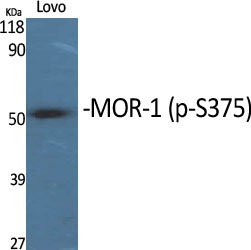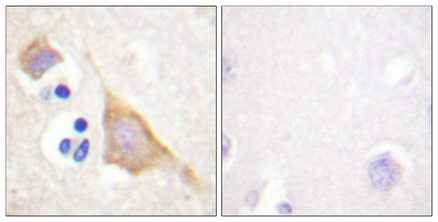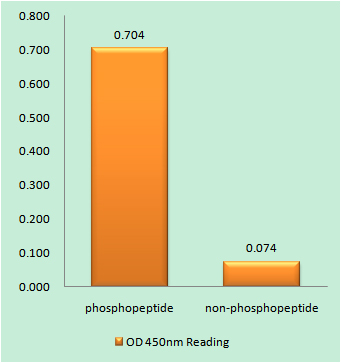MOR-1 (phospho Ser375) Polyclonal Antibody
- Catalog No.:YP0953
- Applications:WB;IHC;IF;ELISA
- Reactivity:Human;Mouse;Rat
- Target:
- MOR-1
- Fields:
- >>Neuroactive ligand-receptor interaction;>>Estrogen signaling pathway;>>Morphine addiction
- Gene Name:
- OPRM1
- Protein Name:
- Mu-type opioid receptor
- Human Gene Id:
- 4988
- Human Swiss Prot No:
- P35372
- Mouse Gene Id:
- 18390
- Mouse Swiss Prot No:
- P42866
- Rat Gene Id:
- 25601
- Rat Swiss Prot No:
- P33535
- Immunogen:
- The antiserum was produced against synthesized peptide derived from human Opioid Receptor around the phosphorylation site of Ser375. AA range:341-390
- Specificity:
- Phospho-MOR-1 (S375) Polyclonal Antibody detects endogenous levels of MOR-1 protein only when phosphorylated at S375.
- Formulation:
- Liquid in PBS containing 50% glycerol, 0.5% BSA and 0.02% sodium azide.
- Source:
- Polyclonal, Rabbit,IgG
- Dilution:
- WB 1:500 - 1:2000. IHC 1:100 - 1:300. ELISA: 1:20000.. IF 1:50-200
- Purification:
- The antibody was affinity-purified from rabbit antiserum by affinity-chromatography using epitope-specific immunogen.
- Concentration:
- 1 mg/ml
- Storage Stability:
- -15°C to -25°C/1 year(Do not lower than -25°C)
- Other Name:
- OPRM1;MOR1;Mu-type opioid receptor;M-OR-1;MOR-1;Mu opiate receptor;Mu opioid receptor;MOP;hMOP
- Observed Band(KD):
- 45kD
- Background:
- This gene encodes one of at least three opioid receptors in humans; the mu opioid receptor (MOR). The MOR is the principal target of endogenous opioid peptides and opioid analgesic agents such as beta-endorphin and enkephalins. The MOR also has an important role in dependence to other drugs of abuse, such as nicotine, cocaine, and alcohol via its modulation of the dopamine system. The NM_001008503.2:c.118A>G allele has been associated with opioid and alcohol addiction and variations in pain sensitivity but evidence for it having a causal role is conflicting. Multiple transcript variants encoding different isoforms have been found for this gene. Though the canonical MOR belongs to the superfamily of 7-transmembrane-spanning G-protein-coupled receptors some isoforms of this gene have only 6 transmembrane domains. [provided by RefSeq, Oct 2013],
- Function:
- function:Inhibits neurotransmitter release by reducing calcium ion currents and increasing potassium ion conductance. Receptor for beta-endorphin.,online information:Mu opioid receptor entry,polymorphism:Variant Asp-40 does not show altered binding affinities for most opioid peptides and alkaloids tested, but it binds beta-endorphin, an endogenous opioid that activates the mu opioid receptor, approximately 3 times more tightly than the most common allelic form.,similarity:Belongs to the G-protein coupled receptor 1 family.,subunit:Forms a complex with G(alpha)z/i2 subunits and the RGSZ proteins, RGSZ17 and RGSZ20. The formation of this complex results in mu-opioid receptor desensitization. Interacts with RGSZ17 and RGSZ20.,
- Subcellular Location:
- Cell membrane ; Multi-pass membrane protein . Cell projection, axon . Perikaryon . Cell projection, dendrite . Endosome . Is rapidly internalized after agonist binding. .; [Isoform 12]: Cytoplasm .
- Expression:
- Expressed in brain. Isoform 16 and isoform 17 are detected in brain.
- June 19-2018
- WESTERN IMMUNOBLOTTING PROTOCOL
- June 19-2018
- IMMUNOHISTOCHEMISTRY-PARAFFIN PROTOCOL
- June 19-2018
- IMMUNOFLUORESCENCE PROTOCOL
- September 08-2020
- FLOW-CYTOMEYRT-PROTOCOL
- May 20-2022
- Cell-Based ELISA│解您多样本WB检测之困扰
- July 13-2018
- CELL-BASED-ELISA-PROTOCOL-FOR-ACETYL-PROTEIN
- July 13-2018
- CELL-BASED-ELISA-PROTOCOL-FOR-PHOSPHO-PROTEIN
- July 13-2018
- Antibody-FAQs
- Products Images

- Western Blot analysis of various cells using Phospho-MOR-1 (S375) Polyclonal Antibody
.jpg)
- Western Blot analysis of Lovo cells using Phospho-MOR-1 (S375) Polyclonal Antibody

- Immunohistochemical analysis of paraffin-embedded Human brain. Antibody was diluted at 1:100(4° overnight). High-pressure and temperature Tris-EDTA,pH8.0 was used for antigen retrieval. Negetive contrl (right) obtaned from antibody was pre-absorbed by immunogen peptide.

- Enzyme-Linked Immunosorbent Assay (Phospho-ELISA) for Immunogen Phosphopeptide (Phospho-left) and Non-Phosphopeptide (Phospho-right), using Opioid Receptor (Phospho-Ser375) Antibody

- Immunohistochemistry analysis of paraffin-embedded human brain, using Opioid Receptor (Phospho-Ser375) Antibody. The picture on the right is blocked with the phospho peptide.



